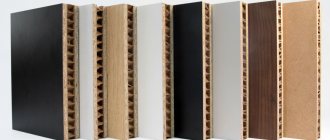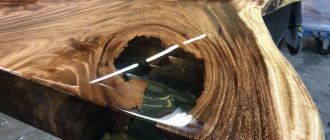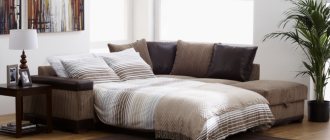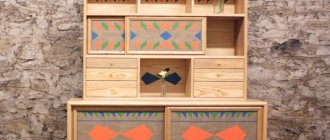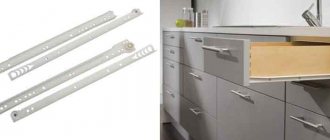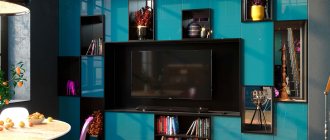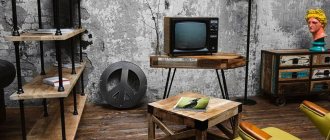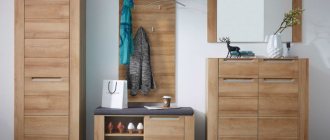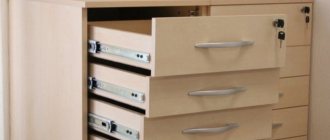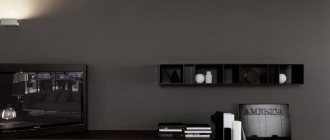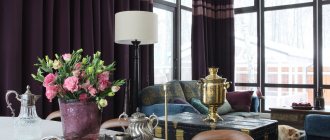When the furniture necessary for a comfortable life in an apartment or house has been selected, funds have been allocated from the family budget, a purchase agreement has been drawn up and the packaged elements of the coveted furniture have been delivered to the address, unforeseen circumstances may arise with its assembly. Suddenly it turns out that the contract does not contain a clause for free assembly of the purchased goods, and financial difficulties have already begun after a major purchase.
Or the store’s specialists can provide this service only in a few days, but you already have a date set for a meeting with family or friends in an apartment with an updated interior. This is where the situation comes when you have to assemble the furniture yourself. This sounds more than terrifying. But the one who walks will master the road.
In this publication we will try to help you perform all operations with maximum success.
Categories, types and designs of wooden furniture
Wooden furniture is so diverse that it is becoming increasingly difficult to bring the wide range of products offered to the buyer to some common denominator. According to the standard classification, furniture is divided according to the following criteria: functional and operational purpose, basic materials and nature of production, completeness, design and technological design.
General recommendations
Once your furniture has been delivered, ensure that the number of boxes matches your order and that all items needed to assemble the furniture you ordered have been delivered.
- Whenever possible, try to always follow the manufacturer's instructions when assembling each item.
- Before you begin assembling furniture, carry out all planned repair and construction work, such as moving utilities or laying tiles.
- Use an angle iron and a spirit level to check the levelness of the floor and walls.
- Assess what material the walls are made of. Our consultants will advise you which fasteners to use to attach cabinets to a specific wall.
- Mark on the wall where the electrical and plumbing systems are located to avoid damaging them when drilling into the wall.
Manufacturers themselves classify furniture according to the following basic characteristics:
1) Depending on the materials used
According to the material of manufacture - chipboard (laminated chipboard), MDF, solid wood (wood panel) and various combined options.
2) By age orientation
Depending on the age orientation (furniture for children, teenagers, adults) - products whose shape, designs and sizes are designed for certain height and age characteristics of people.
3) By the nature of production
According to the nature of production, furniture is divided into:
- experimental production - this includes furniture manufactured in piece quantities (usually up to 10 copies) for exhibitions and artistic and design assessment (determining the manufacturability of production, for testing, analyzing consumer preferences, etc.);
- individual production - furniture made to order according to certain parameters;
- mass production – irregular production of template furniture in large quantities. Usually, after several releases, the series changes, but the saved equipment (templates, forms, calibers) allows production to be resumed if necessary;
- mass production – production designed for the continuous production of large batches of furniture according to a specific template over a long period of time.
4) According to production method
According to the production method, wooden furniture can be:
A) Bent - consists partially or completely of bent elements, which are assembled using metal fasteners (screws, bolts with nuts, wood grouse).
B) Wicker - made by various weaving of flexible wood (mainly from willow branches, bamboo, rattan).
C) Carpentry - furniture assembled from straight elements and parts of complex shapes, made on cutting machines using turning, milling, sawing. The connecting link is various fasteners and glue.
5) Design features
According to design and technological features:
A) collapsible - furniture, the design of which allows for repeated installation and disassembly;
B) non-separable – products with permanent connections;
C) sectional - structures consisting of two or more sections that can be combined, installed next to or on top of each other. This also includes furniture sections that are manufactured as a separate finished product, but can be used in whole or in part as part of a group combined into a block;
D) built-in furniture, the design feature of which is the absence of walls, sides, roof, bottom or all of the above (only sectional partitions, shelves and the front side are required);
E) transformable - furniture items made according to the “two in one” principle - sofa bed, chair bed, table, cabinet, etc.
6) Wooden furniture by destination
By destination - for indoor or outdoor use;
7) Completeness
By completeness:
- single piece of furniture;
- a group of individual products interconnected according to certain constructive, architectural and artistic principles, assembled into a set or set.
 Exploitation
Exploitation
According to operational purpose:
A) for home (household) - includes furniture for a common room, bedroom, bath, dining room, kitchen, office, hallway. This also includes furniture for a summer house and furnishings for a children's (teenage) room;
B) for public enterprises - educational organizations, trade, laboratory, industrial premises, catering, consumer services (including shops, pharmacies, hospitals, administrative premises, medical institutions, hotels, children's schools and preschool institutions, libraries, etc.) d.);
C) for transport - furniture intended for equipping various vehicles. A complete list of furniture broken down into categories and classified according to certain criteria can be found in GOST 20400-80 “Furniture production products. Terms and Definitions".
We collect
| Kitchen furniture |
| Theater chairs |
| Office furniture |
| Furniture at home |
| School furniture |
| IKEA furniture |
| Chinese furniture |
| Children's furniture |
| Italian furniture |
| Metal furniture |
Classification by functional purpose
1) Storage furniture (cabinet furniture) - designed to accommodate various items
This category includes:
- functional cabinets (bookcases, linen cabinets, clothes cabinets, kitchen cabinets, with a display case, under the sink, buffets, cupboards, wardrobes);
- wall cabinets;
- partition cabinets for dividing rooms into certain zones;
- multi-purpose cabinets that do not have a specific functional purpose. These include: secretaries, sideboard cabinets, chests, cabinets, open and closed shelving, wardrobes.
2) Furniture for lying and sitting:
- beds (single, double, multi-tiered);
- sofas are a combined product designed for sitting (and sofa beds - and lying) for several people;
- couch, ottoman, ottoman;
- banquette;
- stools, chairs, benches;
- armchairs – a category that includes: working chairs, chair-beds, rocking chairs, chaise lounges.
3) Furniture for dining
Furniture for eating and working includes all types of tables:
- dining,
- serving,
- toilet,
- writing,
- the Bureau,
- magazine,
- console,
- desk (student's table),
- music stand,
- dressing table
4) Other products
– this category includes wooden furniture of non-standardized terms, for example, various screens, hangers, etc.
The complete list necessary for cataloging furniture and its certification for certain groups can be found in the All-Russian Classifier of Products (class 56).
What tools are needed?
The tools available in the house are suitable for assembling cabinet furniture:
- screwdrivers;
- screwdrivers;
- Sander;
- jigsaw;
- wood hacksaw;
- ruler;
- simple pencil.
The popular design with craquelure varnish makes the facade of the cabinet look original and expensive.
Sandpaper is suitable as a material for cleaning surfaces. In order to measure the elements correctly, it is necessary to do this not on the floor, but on a table, preferably a carpenter's table or something similar. You can use stools as supports when cutting off extra centimeters from the board.
To assemble a cabinet or chest of drawers, you must first calculate the parameters of the future product.
Let's transform! Review of folding and simply compact furniture that does not encroach on the living space
Receive one of the most read articles by email once a day. Join us on Facebook and VKontakte.
Sometimes the only way to unload the kitchen is to compress the set to the size of the table. Modular kitchen-table 360 Mobile Kitchen is a solution that is relevant for narrow apartments with an area of 8 m², mobile homes and small-sized housing, such as Khrushchev apartments. Farsiska Winter, Ulrike Sandner and Katrin Sillman are working on bringing the conceptual ergonomic kitchen to life. German designers assure that their design, convenient from all sides, is also suitable for use in the fresh air.
Latvian designer Rolands Landsbergs specializes in designing space-saving, futuristic Boxetti furniture. For example, Boxetti Private is a modular bedroom that includes a double bed, a night table and a wardrobe. In addition, the furniture unit is equipped with spotlights. And thanks to the remote control, folding the “platform” for sleeping is as easy as turning on the TV. The closet has all the necessary compartments - from shelves and drawers to a clothes hanger. A bedroom in the style of films about the future can be purchased on the manufacturer’s official website for € 7,866 (about $ 10,438). The Rolands collection also includes a fold-out kitchen, living room and study.
No matter how trivial it may sound, Café&Leche from Spanish creatives from Ebuala is more than an ordinary sofa. The flexible design from a sleeping place for two persons can easily be transformed into a sofa, a sitting area and even a pair of armchairs with a table in the middle.
German “interior designers” Sebastian Mühlhäuser and Marcel Krings have found a fundamentally new solution for saving square meters. When disassembled and put together, the pieces of furniture from the Casulo set look like an ordinary 80*120 cm box. However, a whole room fits inside it. At the same time, the useful area of the table in “unfolded” form is 80*160 cm, the bed area is 200*80 cm. Assembly does not require any tools and takes about ten minutes. The Casulo box furniture set is an ideal solution for owners of small spaces and those who do not like to live in one place for a long time. By the way, Sebastian and Marcel are not the only ones who thought of inventing compact and mobile furniture.
Aspiring Kharkov designer Yulia Kononenko quickly realized the benefits of multifunctional furniture with transformable capabilities. And she designed the Convertible Sofa - a sofa that can be transformed into a dining table with ottoman chairs at the request of the owners. According to Yulia, such interior solutions will help end the eternal struggle between people and furniture for living space.
Made from a thick layer of plastic, the chairs from Daniel Milchtein Peltsverger are good not only because of their colorful colors and minimalist design. Individual seating areas stacked on top of each other create a stable sofa that takes up less space.
With the help of hidden mechanisms, a standard-looking “single-seater” sofa Doc sofa bunk bed folds out into a two-story bed. The area of each bed is 0.9*2 meters, the height of the “attic” is 1.39 m. You can get more detailed information, find out prices or purchase Doc sofa bunk bed on the manufacturer’s website.
Philippe Malouin prefers to expand space using non-standard and, from the point of view of critics, controversial methods. The concept of almost universal furniture, Unit, developed by Philip, involves combining a kitchen... with a bathroom. A long table for culinary experiments and eating is connected to a refrigerator and a sink. If you remove part of the “countertop” from the sink, the place for washing dishes is transformed into a full-fledged bath.
The Circular sofa bed from the Italian brand Saba will appeal to owners of studios and one-room apartments in which the bedroom is combined with a living room who do not want to live in cramped spaces. After lifting, the Circular sofa bed can be “split” into two sofas.
The Tavoletto Collection modular dining table is an ergonomic invention by Italian designer Federico Floriani. The shape and size of the parts make it possible to assemble completely different combinations from them - from a coffee table and a workplace to a bed with a shelf for lovers of late-night snacks.
Did you like the article? Then support us, click
:
§ 2. Classification of furniture
Furniture is classified according to purpose, design, structural and technological characteristics and the nature of production.
By purpose
furniture is divided into two large groups: for public spaces and residential (household).
In turn, in both groups, furniture is classified according to the zones for which it is intended. Thus, furniture for public premises can be intended for equipping auditoriums, presidium seats, rest areas at train stations, etc. beaches, parks. Household furniture is divided into furniture for living rooms, kitchens, hallways, bathrooms, terraces and other premises. The classification scheme for household furniture is shown in Fig. 1. Fig.
1. Classification scheme for household furniture The cabinets and cabinets for living rooms indicated in the table in the figure can be combined, that is, designed to perform several functions and a specific purpose, for example, cabinets for clothes, books, dishes; cabinets for bedding, TVs, radios, toilets.
Tables for living rooms are divided into dining tables, desk tables, toilet tables, coffee tables, serving tables, and tables for TVs and radios.
Kitchen cabinets are divided into work cabinets, tables, sink cabinets and wall cabinets, and tables are divided into work cabinets and dining cabinets.
A special group consists of stationary partition cabinets and built-in wall cabinets, installed during the construction of a building. Wardrobe partitions are used instead of interior partitions in apartments. They serve adjacent rooms or other adjacent spaces in the apartment. Built-in wall cabinets are placed close to the wall or built into wall niches; they serve only one room or one room.
Depending on the purpose, furniture is also divided into individual models, sets and sets.
Model
- this is a sample of a certain type of furniture product, the design of which is completed, for example, a carpentry chair, a sideboard.
Each model can have its own varieties, made differently in color, material, type of cladding, finishing and elements that have a decorative (rather than structural) purpose. This achieves a variety of manufactured products of this model.
Set
– this is a target group of furniture products intended for furnishing a specific room (bedroom, dining room, kitchen, terrace) or a separate area in a common room - a relaxation area, a sleep area (for example, sets for a bedroom, dining room, terrace).
Kit
is a group of furniture products for furnishing a residential apartment (or room), which has several functional purposes. Sets also include groups of similar furniture products that do not fully provide the furnishings of residential apartments or rooms, but are united by some common design and technological features. The set may include both sets of different purposes, as well as individual products (for example, sets for one-, two- and three-room apartments, a set of cabinet furniture consisting of three similar items).
By design
furniture can be panel, frame or mixed.
Products in which panel elements predominate are called panel
, and products in which frame elements predominate are called
frame
.
Products consisting of panel and frame elements are called mixed
.
In addition, according to the design, furniture is divided into veneered and non-veneered, sectional and non-sectional, non-dismountable and collapsible, folding, transformable.
Sectional
furniture is called furniture consisting of separate sections and structural elements, different combinations (arrangements) of which make it possible to form objects of various sizes, shapes and functional purposes. Sectional furniture is divided into: three main groups; into interlocking (composed of volumetric elements), universally prefabricated (composite of planar elements) and racking (composite of planar and volumetric elements).
Lockable furniture (Fig. 2, a) includes separate cabinet sections equipped with all the necessary elements: shelves, drawers, doors, rods. Sections can be freely arranged in both width and height, and can also be used as separate items.
Rice. 2. Schemes of sectional furniture: a – lockable, b – universally prefabricated, c – shelving
Universal prefabricated furniture (Fig. 2, b) consists mainly of standardized walls, doors, shelves and other flat elements assembled using fastening fittings into products for a specific purpose. The composition of universally prefabricated furniture can also include three-dimensional elements: drawers, support benches, etc. The design of the elements of universally prefabricated furniture allows you to assemble products according to various schemes. A distinctive feature of universal prefabricated furniture is the absence of double horizontal and vertical walls in the assembled products.
Shelving furniture (Fig. 2, c) consists of planar (shelves) and fully assembled volumetric elements (sections), mounted on load-bearing racks. Sections and shelves can be attached to racks at any height and in any order. A type of sectional shelving furniture is furniture mounted on load-bearing supports.
Products, depending on the method of connecting their parts, can be non-separable or collapsible
.
The parts of a non-separable product are connected using glue, welding, firmware, screws, and staples. Products of this type are usually assembled at the manufacturer. It should be noted that connections using screws can also be classified as partially dismountable. Parts of a collapsible product are connected with various ties, bolts, screws, and running joints. Products of this type are usually finally assembled from the consumer.
Non-separable and collapsible products can be transformable and foldable.
Transformable product
has a special design that allows you to either change its purpose (for example, from a chair to a bed), or to modify its shape and size (for example, from a dining table with a round lid to a dining table with a large oval lid).
Folding product
has a hinge or other connection of the main parts, which allows them to be folded, reducing the size of the product and the volume they occupy.
According to design and technological characteristics
A distinction is made between carpentry furniture, cabinet furniture, block furniture, soft and semi-soft furniture, bent furniture, wicker furniture, as well as furniture made of metal, plastics and other materials.
Carpentry
is called veneered and non-veneered furniture, the design of which includes parts and assemblies made from wood and wood materials. The timber parts of carpentry furniture are processed by cutting (sawing, milling), and not by bending.
Corpus
is called furniture, the main part of which is a body made of panels, slabs, frames with panels. Cabinet furniture includes cabinets and cabinets of all types, tables with cabinets (desks, toilets).
Bar furniture is furniture consisting of bars of different shapes and sizes (chairs, work chairs, stools, children's beds).
Soft and semi-soft
is called furniture, the main parts of which consist respectively of soft and semi-soft elements (sofas, sofa beds, chairs, armchairs). The main element that determines the soft or semi-soft category is the seat.
Chairs and armchairs are called hard
if their seats do not have an elastic part or have a flooring made of elastic materials with a thickness of no more than 10 mm.
Bent
is furniture, the main parts of which are made by bending. There are also furniture using bent-glued and bent-propyl elements.
Wicker
refers to furniture made by weaving materials that, as a rule, have a constant profile in their cross-section. It is usually made from steamed vine twigs, ribbons, and cords. The frame of such furniture can be either wooden or metal.
Recently, furniture has begun to be made using metals and plastics. Metals and plastics are included as components in carpentry, upholstered, semi-soft, bent and wicker furniture.
By nature of production
furniture is divided into experimental, serial and mass-produced.
Experimental furniture
manufactured for consideration at artistic and technical councils, demonstration at exhibitions and fairs in order to identify buyer demand for it. Sometimes experimental products are put into trial operation to determine their ease of use and their structural strength. Some experimental products are tested according to approved methods.
Serial furniture
produced in more or less large batches (series) based on the results of manufacturing and testing of experimental samples. At the same time, repetition of series is provided, during which the design of products is improved.
Mass furniture
are produced in large quantities continuously and for a long time without changing its design, according to drawings that have been finalized and verified during the production of series.
Go to Vulcan Platinum, the official website, which will help you get comfortable with the variety of slot machines
Preparation before assembly
The selected material - chipboard, chipboard or solid wood panels - must be properly processed. Preparing the parts of a cabinet or chest of drawers involves leveling the surfaces, if it is not a laminated base, as well as cleaning them from roughness and burrs. The cut edges of the chipboard can simply be sanded and covered with a matching laminated edge.
Spot lighting is also a practical addition.
Any material that you are going to use must be of high quality and well dried so that after production the product does not create dangerous chemical fumes in the room.
Before assembling cabinet furniture, you need to carefully measure the area where the structure will be installed. For a cabinet with doors, you need to leave a little free space so that the doors can open without the possibility of friction against the walls.
You can use a power tool in your work, which simplifies the attachment of a particular part to the body.
Repeated parts of the future product must be symmetrical to each other, otherwise misalignment is likely.
Select fasteners after you have decided on the base material. Try to purchase reliable connecting parts. They should be purchased with a reserve so that if they fail, they can be easily restored.
Sandpaper is suitable as a material for cleaning surfaces.
Design features of joinery
Any furniture must be comfortable to use, durable, and in appearance and size correspond to its purpose; it must also meet sanitary, hygienic and aesthetic requirements, and be affordable to the general consumer at a price.
Ease of use depends on the correct choice of design and shape of furniture. Furniture should be light and adapted to the room in which it is used. Based on scientific research and practical data, the most appropriate sizes of furniture and its components have been established, therefore all enterprises produce furniture of more or less standard sizes.
We have already said that the shape of the furniture should provide ease of use. For example, the back of a chair should have an inclination of 10-14°, the back of a chair – 10-15°. The seats of chairs and benches should be tilted down 1.5-2° towards the back. The height and depth of the seat of a chair and stool, the height of a table, etc. must exactly match the size and shape of the human body. Desk and bureau drawers should be placed so that the person sitting behind them can pull them out comfortably. For convenience, in two-pedestal desks there is often no middle drawer between the pedestals; For single-stand tables, the stand should be placed on the left side of the person sitting at the table.
In desks and kitchen tables, the drawers are made in such a way as not to interfere with the person sitting at them.
Bedroom furniture and furniture intended for cultural centers and clubs should create conditions for relaxation.
The strength of furniture depends on the design, size of parts, methods of connecting parts and assemblies. It also depends on the quality of the materials and their processing.
The components of furniture are subjected to compression and bending forces, less often to tension and chipping.
Wood is more resistant to compression and tension along the grain, and is more resistant to shearing forces across the grain. When designing furniture, you need to connect the parts in such a way that they are in the most favorable conditions.
To obtain durable furniture, you need to design it so that the direction of the fibers and layers in individual parts coincides with the direction of compressive and tensile forces and is perpendicular to the bending force. If you do not adhere to this rule, the product will quickly collapse, even if the cross-section of the component parts is increased.
The drawer of a chair, stool and table is subject to bending, so it is also necessary that the direction of the fibers in the component parts of the drawer be perpendicular to the forces acting on it.
The cross-section of individual structural parts of furniture is determined depending on the quality of the material from which they are to be made. Therefore, when designing furniture, it is necessary to maintain the established dimensions, which will ensure the required strength of the product and at the same time economical consumption of wood.
During use, individual structural parts of furniture, if the wood dries out and cracks, change shape and size. Therefore, furniture must be designed in such a way that the dimensions of the components can be changed freely. Failure to comply with this rule may result in a reduction in the useful life of the furniture, a decrease in its artistic value, or damage to individual parts or even the entire item. For example, the seat of a stool with the base must be connected in such a way that the deformation of the seat due to changes in temperature and humidity of the surrounding air occurs freely, without changing the shape and strength of the entire product. If we connect such a seat tightly, it will become deformed and quickly wear out.
To maintain the original size of parts, such as side walls and cabinet doors, and to protect them from warping, they are made in the form of a frame with bars proportional in thickness and width. On the inside of the frame contour, they are connected into a tongue and groove, into which the centers of these parts fit freely without fastening. The tongue and rebate must be of such dimensions that when maximized, the center does not reach the bottom of the groove or the border of the rebate. On the other hand, the center must be inserted to such a depth that when it dries and reduces its size, it does not fall out of the frame.
This design of the side walls and cabinet doors protects the middle from warping and preserves the dimensions of the product.
The side walls, doors and other components, as well as the product as a whole, are made not of monolithic wood, but of slabs consisting of glued layers of wood of various thicknesses.
When gluing layers, you need to ensure that the direction of the fibers in adjacent layers is perpendicular. This is done so that the glued slabs do not change size and shape. The greater the number of layers a slab has, the more resistant it is to changes.
When designing a model, you need to assume that the execution of parts and the assembly of the entire product take place on a production line.
Modern woodworking machines can perform all operations necessary in the production of furniture, even such as imitation, carving and varnishing.
The wood intended for the manufacture of furniture must be dry and meet technical specifications, the glue must have a high bonding ability and produce an elastic adhesive seam.
The artistic value of furniture is achieved through the correct selection and proportional sizes of the components and appropriate finishing. From the point of view of saving material, structures made of monolithic wood are used less frequently; they are replaced by glued structures of the following types: frame-panel, particle board, laminated or not laminated on the front side with plywood, glued plywood and solid fiber boards.
Frame-panel structures consist of bars connected to each other using carpentry joints. The long bars that make up the frame are called longitudinal, the short ones are called transverse, and those located inside the frame are called median.
The shape of the frame can be straight (bars connected at right angles) or oblique (bars connected at an acute or turned angle).
The filling of the frames is called the middle. The cores inserted into the frames can be made of plywood, rigid fiberboard or boards. If the frame is made of large sizes so that the middle in it is not strong enough, then additional middle bars are used. To smooth out the difference in levels between the bars and the middle or to decorate the edge of the bars, choose a profile or make a decorative overlay.
Materials
To obtain high-quality products, different types of raw materials are used; materials for production must be selected carefully. Wood is best. However, solid massifs are expensive, so forest industry waste is popular:
- Chipboard. This material is the cheapest, but its design is very attractive and allows you to arrange your home in an interesting way. It should be taken into account that when heated strongly, toxic substances are released, so placing chipboard furniture near the radiator is not the best solution.
- Chipboard. It is a chipboard covered with a special film. The plates have poor resistance to physical influences. Can imitate different types of wood. Kitchen units are often made from laminated chipboard, since the boards have high resistance to temperature changes.
- Fiberboard. Plates made of this material are extremely difficult to fasten together, so the back walls and bottoms of cabinets are made from it. The appearance resembles ordinary cardboard.
- MDF. Safe and durable raw materials for furniture. Easily deformed, which allows you to make interesting bends. The material is durable and waterproof, so it will last for many years in rooms with high humidity. However, in the event of a breakdown, you will not be able to repair the furniture yourself.
The PVC edge provides additional protection to the product and helps to avoid injury and damage to clothing by smoothing out any unevenness.
Chipboard
laminated chipboard
Fiberboard
MDF
Wood
PVC
